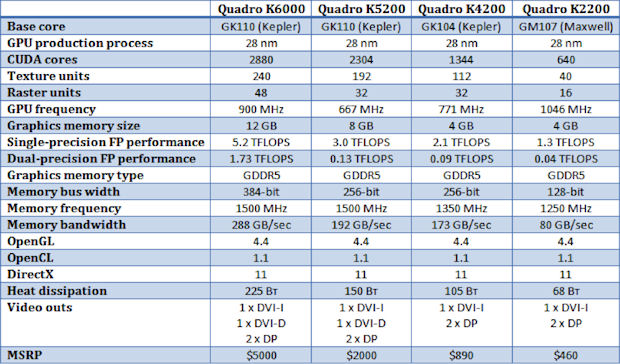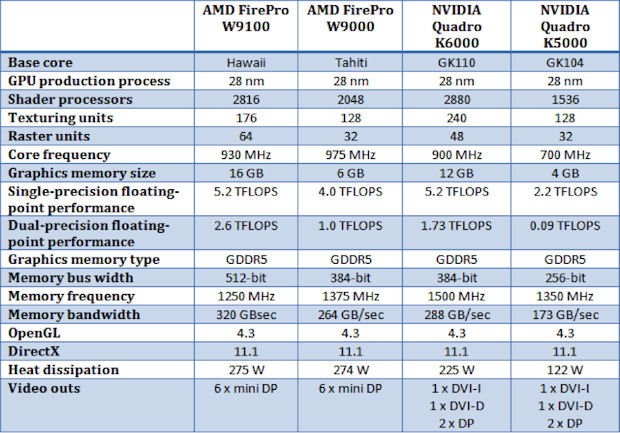New Computing and Graphics Processors Drive Engineering Innovation

NVIDIA’s updated Quadro products feature more onboard memory (twice the amount of their respective predecessors) and are designed to work better with complex models and at higher, 4K resolutions.
November 1, 2014
If one thing could be said about the latest crop of processors, it’s that Moore’s Law is still in full effect. Evidence for that decades-old theory can be found in Intel’s and AMD’s latest offerings, backed by an onslaught of new video card offerings.
Intel Brings More Cores to the Party
With its Sept. 8 launch of its latest Xeon processors (code named Haswell-EP and Haswell-EN), Intel aimed to maintain its lead in the high-performance and server computing market. The Xeon E5-2600 V3 family of processors, based on Haswell microarchitecture, features as many as 18 cores. It uses the C612 chipset, with improved performance in an R3 socket over its predecessor, the Xeon E5- 2600 V2, which is based on Ivy Bridge architecture.
“The higher core count brings significant performance improvements over the previous generations, as well as improved peripheral expansion,” says Intel Workstation Segment Manager Wes Shimanek.
During the launch event at the Intel Developer Forum (IDF) in California, Intel’s SVP of its Data Centre group, Diane Bryant, said, “From a performance perspective, we are delivering worldwide performance levels, tripling performance [thanks to] the Xeon V3’s 18 cores [that] offer a 50 percent increase over the prior generation.”
Beyond an increase in cores and a redesigned microarchitecture, performance gains offered by the latest Xeons come from innovations such as the switch to DDR4 memory of up to 2,133MHz, outpacing Ivy Bridge’s 1,866MHz DDR3 memory.
“We are continuing to be the most energy-efficient processor on the planet, and have achieved 27 world records in performance across the product line,” Bryant said.
On the heels of the Intel launch, major workstation vendors announced new systems that will leverage the power offered by Intel’s latest Xeons.
HP was quick to demonstrate its latest high-performance workstations at a press-only event at its Fort Collins, CO headquarters in early September. At the event, Jeff Wood, worldwide product manager for the HP workstation business, explained that the new HP Z Desktops and ZBook Mobile Workstations are built to address the constraints of compute-intensive industries.
By combining the latest technologies, HP is offering workstations that speed the most intensive processes for design and simulation. For example, the top-of-the-line Z840 supports up to 36 cores, 1TB of error-correcting code (ECC) memory, and two NVIDIA K6000 (12GB) graphics cards in a full-size tower configuration.
Jim Zafarana, VP and general manager of HP’s commercial solutions unit, said at the event “the new Haswell processors, when paired with the latest in high-performance graphics cards, allow HP to bring exceptional levels of performance to engineering, design and simulation users.”
HP isn’t the only one delivering the latest Haswell processors in workstation form. Dell has introduced tower and rack workstations based on the new Intel Xeon E5-2600 v3 and E5-1600 v3 processors. The company claims that the new workstations, which are equipped with 2133MHz DDR4 memory, perform as much as 4.7 times faster than the previous generation, making it possible to design and iterate faster than ever.
“Every key component of our new workstations has been updated, resulting in outstanding performance gains to help our customers design without limitations,” says Thaneth Angkasirisan, country manager, Dell Corp.
AMD’s Latest FX Processors Focus on Value
AMD also had some CPUs news of its own in early September. The company introduced a trio of eight core CPUs built on AMD’s 32nm Piledriver architecture. From a performance standpoint, it would be unfair to compare AMD’s 32nm architecture to Intel’s latest Haswell 22nm architecture; however, AMD’s is focusing on value. AMD’s 4GHz FX-8370 and 3.3GHz FX-8370E are priced as $199.99 each, while the 3.2GHz FX 8320E is priced at $146.99.
 With specs evolving and the GPU wars in full swing, one cannot think about AMD’s FirePro GPUs without comparing them to market leader NVIDIA, which aims to hold onto the performance GPU market with its Quadro GPUs.
With specs evolving and the GPU wars in full swing, one cannot think about AMD’s FirePro GPUs without comparing them to market leader NVIDIA, which aims to hold onto the performance GPU market with its Quadro GPUs.AMD’s new FX processors are geared toward enthusiasts, and the company is touting high clock speeds as an advantage, as indicated by Bernd Lienhard, corporate vice president and general manager, Client Business Unit, AMD.
“Enthusiasts can experience seamless multitasking and unleash the real capabilities of multi-threaded applications with additional enthusiast performance-tuning features unlocked as standard,” Lienhard says. “World-record frequencies are just a start.”
For engineers looking to build multi-display, low-cost systems for HD content creation, the latest FX processors from AMD may be a viable choice—especially when cost is a key concern.
AMD, NVIDIA Bring Next-generation GPUs to Market
Both AMD and NVIDIA have launched new graphics cards that feature faster and more efficient silicon, pushing graphics processing unit (GPU) performance upward.
 NVIDIA’s updated Quadro products feature more onboard memory (twice the amount of their respective predecessors) and are designed to work better with complex models and at higher, 4K resolutions.
NVIDIA’s updated Quadro products feature more onboard memory (twice the amount of their respective predecessors) and are designed to work better with complex models and at higher, 4K resolutions.Building upon its recently introduced Maxwell graphics architecture, NVIDIA has launched the GeForce GTX 980 and GTX 970. The new cards add more efficient multi-frame anti-aliasing, as well as Dynamic Super Resolution, which will render content at 4K and then downscale it for an improved 1080p image. NVIDIA has also added improvements for virtual reality processing by including the assignment of one or more GPUs to render the visuals for a specific eye.
Although the GTX 980 and the GTX 970 are geared toward the gaming market, NVIDIA’s latest Maxwell-based cards do offer advantages for those looking at simulation and design. NVIDIA’s Tom Petersen touts the enhancements as ideal for hardcore gamers, but notes that “Voxel Global Illumination is a technology that can simulate light in real-time, creating scenes that are much more realistic, vastly improving the quality of real-time rendering.”
However, NVIDIA’s performance-leading GPUs remain with the Quadro product line—with the well-established K6000 at the top of the heap. A new lineup of Quadro GPUs, in the form of the K5200, K4200, K2200 and K620, are squarely aimed at archrival AMD’s FirePro series of GPUs.
AMD’s latest GPUs include the FirePro W9100, which the company says is designed for the next generation of 4K workstations accelerated by OpenCL, and can deliver as much as 2.62 teraflops.
“The AMD FirePro W9100 is designed to deliver ultimate visual supercomputing performance for the next generation, ultra-high-resolution workflows,” says Raja Koduri, corporate VP, AMD Visual Computing. “This professional graphics card is optimized and certified for leading workstation applications, and ensures ultra-high geometry performance and smooth handling of complex models.”
More Processor News on the Horizon
Announced in July, Intel’s latest Core M is the first consumer-level processor to use the latest 14nm design. Positioned as a low-power usage, system on a chip (SoC) processor, the Broadwell-Y based Core M creates a great deal of opportunity for those designing mobility products or embedded devices.
Broadwell-Y can be used as the basis to manufacture a range of products, from high performance to low power. Improvements include a redesign of each transistor fin, which is now denser, making the 14nm much smaller and more efficient, and allowing for the creation of “fanless” devices.
Broadwell-Y’s SoC design delivers lower capacitance. Intel says it reduces power input by 25% and minimum operating voltage by 10%, which saves an estimated additional 20% in power consumption. Also, Broadwell-Y offers 10% to 15% performance per transistor increase through the use of low-voltage, optimized 14nm transistor technology, backed by 2x lower leakage. This further reduces power consumption by 10%, as most of the power is utilized instead of being lost to leakage.
“The goal with Broadwell-Y was to make an 8mm to 10mm thick device, with a 10.1-in. display that was fanless with a 3 to 5 Watt SoC,” explains Stephan Jourdan, Intel Fellow and director of SoC Architecture at Intel. “Intel needed to optimize the CPU, GPU, PCH and move onto the 14nm process to create a sub-5 Watt SOC that could fulfill such a role.”
More Info
Subscribe to our FREE magazine, FREE email newsletters or both!
About the Author
Frank OhlhorstFrank Ohlhorst is chief analyst and freelance writer at Ohlhorst.net. Send e-mail about this article to [email protected].
Follow DERelated Topics






